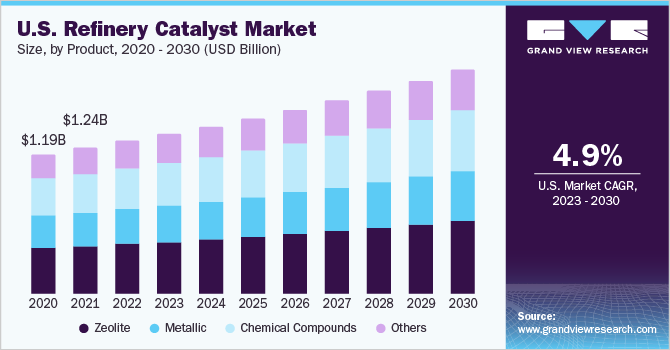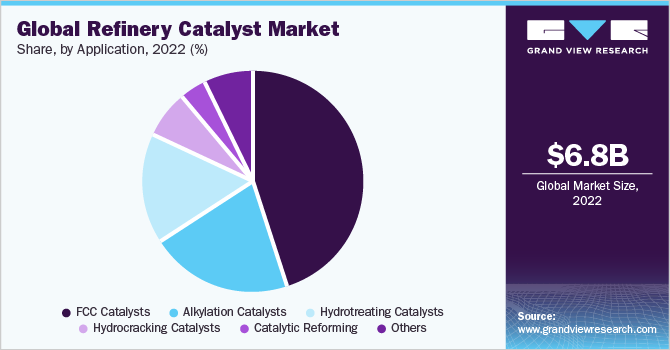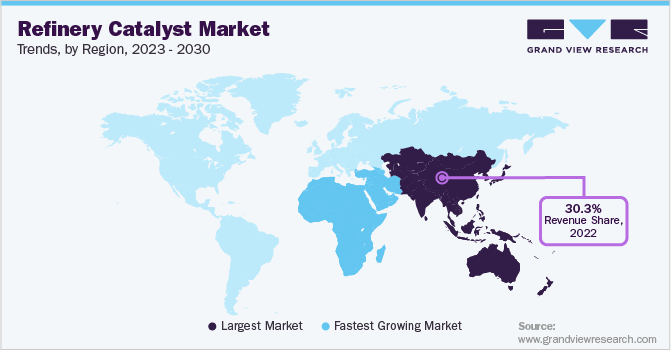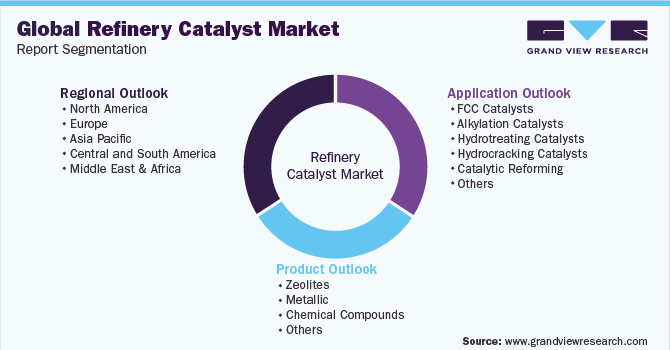- Home
- »
- Catalysts & Enzymes
- »
-
Refinery Catalyst Market Size, Share & Growth Report, 2030GVR Report cover
![Refinery Catalyst Market Size, Share & Trends Report]()
Refinery Catalyst Market Size, Share & Trends Analysis Report By Product (Zeolites, Metallic, Chemical Compounds), By Application (FCC, Alkylation, Hydrocracking), By Region, And Segment Forecasts, 2023 - 2030
- Report ID: 978-1-68038-572-4
- Number of Report Pages: 200
- Format: PDF, Horizon Databook
- Historical Range: 2018 - 2021
- Forecast Period: 2023 - 2030
- Industry: Specialty & Chemicals
Refinery Catalyst Market Size & Trends
The global refinery catalyst market size was valued at USD 6.75 billion in 2022 and is expected to grow at a compound annual growth rate (CAGR) of 5.0% from 2023 to 2030. The market is expected to grow on account of the increasing demand for transportation fuel globally. Stringent regulations coupled with increasing demand for petroleum and petroleum-derived products/chemicals are likely to steer market growth. Refinery catalysts are used in the petroleum refining industry to enhance the operational efficiency of petroleum. In addition, the increasing demand for high-octane fuel, particularly in countries such as U.S., Japan, Germany, U.K., and India due to stringent regulations is expected to positively influence the growth of the market for refinery catalysts. Furthermore, the shift towards renewable energy sources has prompted oil refineries to optimize their operations and improve their efficiency, leading to an increased demand for advanced refinery catalysts. The market is also expected to benefit from the growing adoption of new and advanced technologies in the refining industry, which require specialized catalysts to ensure optimal performance.

Refinery catalysts are widely used to counter issues such as metal contamination and heat balance effect in tight oil processing. Increasing tight oil production in the U.S., Russia, China, and Argentina is expected to drive market growth over the forecast period. Stringent government regulations including those related to Ultra-low Sulfur Diesel (ULSD) and strict emission standards in mature economies are anticipated to remain the major factors steering demand for refinery catalysts in the petroleum refining sector. The availability of alternative fuels such as biofuel coupled with the adoption of “Go Green” campaigns and environmental policies by several nations is expected to restrain the growth of the market for refinery catalysts.
Different types of materials used in the manufacturing of refinery catalysts include zeolites, chemical compounds, and metals. These materials when used in different compositions or in combination with other chemicals help manufacturers produce fluid catalytic cracking refinery catalysts, alkylation refinery catalysts, hydrotreating refinery catalysts, and hydrocracking refinery catalysts.
Global manufacturers of refinery catalysts are highly focused on designing catalysts that can handle all kinds of feedstock and ensure stable, reliable, easy, and profitable hydrotreating and hydrocracking applications. For the same, the adoption of superior process designs, proprietary equipment, and innovation of performance refinery catalysts has helped the manufacturers gain a competitive edge over the others. Further, a combination of technical expertise and sustainable approaches to production is increasingly being adopted by manufacturers.
The global catalyst market has witnessed a significant growth rate over the past few years owing to the benefits it has received from high-value product segments. For instance, the application of catalysts in an automobile reduces carbon emissions that are harmful to the environment and, thus, their application is highly promoted by governments globally. Favorable government regulations, in turn, have increased the demand for catalysts in the automotive industry across regions.
The global demand for transportation fuel is likely to drive growth in the refinery catalysts industry. Stringent fuel norms and standards coupled with increasing consumption of petroleum derivatives are expected to steer the market growth. Government rules governing ultra-low sulfur diesel (ULSD) and severe emission standards in developed markets are expected to continue to drive catalyst demand in the petroleum refining industry. Furthermore, rising demand for high-octane fuel, particularly in major cities in the U.S., Japan, Germany, the U.K., and India, is likely to boost market growth.
Favorable environmental regulations as a result of the non-harmful effects of refinery catalysts in various industries have been a major factor driving the market over the past few years. Stringent emission norms and regulations in relation to various application sectors and the growing use of catalysts for environmental and chemical applications are anticipated to augment the market growth.
Stringent emission control regulations globally are one of the major factors driving the requirement for conservative and efficient refining processes with high yields. This has further resulted in surged refinery catalyst demand to improve overall process efficiency. Stringent regulations concerning emissions have been introduced by many countries for reducing sulfur content in diesel and gasoline as well as reducing the levels of sulfur, nitrogen oxide, and mercury emissions from the refineries. Thus, environmental regulations are driving the demand for environmental catalysts for reducing emissions in refineries.
Increasing energy demand coupled with growing stress on green technologies has resulted in catalysts playing an important role in petroleum refining operations. They are useful in various processes including reforming, hydroprocessing, and cracking operations in refineries. Increasing emission control regulations globally are driving the need for efficient and conservative processes with high yield, which has steered catalysts demand in different applications to improve process efficiency.
In terms of the application segment, FCC and HPC catalysts account for a dominant share throughout the forecast period. Surging high octane gasoline requirements in vehicles to enhance fuel economy to steer product demand in the future. Raw material demand-supply imbalance and volatile prices are expected to hinder market growth over the forecast period.
Product Insights
The Zeolite product segment dominated the market with a revenue share of more than 32.9% in 2022. This is attributed to their widespread usage as adsorbents and catalysts owing to their porosity and large surface area. The porous structure of zeolites accommodates a variety of cations such as potassium (K+), sodium (Na+), calcium (Ca2+), and magnesium (Mg2+).
Naturally, zeolites are formed by the reaction of volcanic rocks and ash layers with alkaline water. Natural zeolites are impure owing to the presence of other minerals, metals, and quartz. On the contrary, zeolites are commercially manufactured from the slow crystallization of silica-alumina gel and multiple other atoms incorporated to improve activity and performance in a particular process.
The metal catalyst to be used in the process is selected based on the type of feedstock, desired cycle length, and end product to be obtained. Companies such as Clariant and BASF SE are the major manufacturers and suppliers of FCC and hydrocracking catalysts across various regions.
Growing demand for noble and other metals in emerging economies of Chile, China, and South Africa on account of favorable regulatory support for FDI in mineral production is expected to ensure a robust raw material supply for the manufacturers of metal catalysts. However, the growing demand for these metals in other applications is expected to put additional pressure on raw material supply and may create obstacles sto the growth of the refinery catalyst industry over the forecast period.
Application Insights
The FCC catalyst application dominated the market with a revenue share of over 45.1% in 2022. The growth in this segment can be attributed to the growing demand for gasoline as a fuel for its use in automotive vehicles across the globe. Other application-based segments include fluid catalytic cracking (FCC) catalysts, hydrotreating catalysts, hydrocracking catalysts, and catalytic reforming.
Fluid catalytic cracking is the most preferred method used by refineries to convert heavy and high boiling hydrocarbons to lower valuable fractions. Gasoline is the primary material obtained from the process along with other fractions such as diesel and C3 and C4 gaseous fractions. This process helps produce an additional quantity of gasoline to cater to the robust demand for automotive vehicles. The lighter fractions formed in the process are fed to the alkylation unit to produce a high-octane gasoline component called alkylate and the heavier fractions are used as a blender and an additive in diesel.

The hydrotreating process, also known as the hydrodesulfurization process, is used to separate chemically bound sulfur compounds from various petrochemical materials. This is done using a variety of refinery catalysts that are selected based on feed. The process also aids in the removal of other impurities such as metals, oxygen, and nitrogen. This unit is used at multiple stages in the refinery for hydrotreating various products that include jet fuel, pyrolysis gas, catalytic feed, reformer feed, and other distillates.
Hydrotreating is carried out before processes such as catalytic reforming to avoid the contamination of the catalyst by crude feedstock. Also, hydrocracking is used before catalytic cracking to reduce sulfur content, enhance yields, and elevate middle distillate petroleum fractions for heating fuel oil, kerosene, and diesel fuel.
Regional Insights
Asia Pacific region dominated the market with a revenue share of more than 30.3% in 2022. An increasing number of private sector companies play a crucial role in promoting the refining industry in the aforementioned countries, especially in India. Reliance-operated Jamnagar refinery complex in Gujarat had a capacity of 1.2 million barrels per day in 2019, which was the largest refinery in the world. The government of India has approved Petroleum, Chemicals, and Petrochemicals Investment Region (PCPIR) policy for promoting FDI investments in the oil and gas sector. This regulatory move is expected to accelerate the petrochemicals and polymer production in India, thus contributing to the demand for refinery catalysts over the forecast period.
The Asia Pacific refinery catalysts market is expected to increase significantly owing to rising energy consumption in emerging economies such as China and India. The presence of substantial oil reserves in China is likely to contribute to Asia Pacific market growth. As a result, key market players are concentrating their focus on expanding capacity in the Asia Pacific region and meeting growing demand across regions.
Refineries in Europe are suffering from low margins on account of high manufacturing costs coupled with stringent environmental regulations. This regulatory move in Russia is expected to fuel demand for catalysts in refining applications. In addition, technological development related to enhanced oil recovery and deploying hydraulic fracturing activities in countries including Russia and Ukraine is expected to create an upsurge in the availability of tight oil and shale gas. Increasing shale gas and tight oil availability are expected to allow raw material access to refineries operating in Germany, France, and Italy. This is likely to have a positive impact on the market for refinery catalysts.

Owing to high manufacturing costs and severe environmental laws, European refineries are experiencing low profitability. This legislative change in Russia is likely to boost catalyst demand in refining applications. Furthermore, advancements in technology for increased oil recovery and the deployment of hydraulic fracturing activities in Russia and Ukraine are likely to increase the tight oil and shale gas supply. Increased shale gas production and tight oil supply are projected to improve raw material supplies to refineries in Germany, France, and Italy, leading to a positive influence on the catalyst industry.
European Commission’s inclination towards reducing Greenhouse Gas (GHG) emissions coupled with regulatory bills intended to promote the biofuels industry is expected to increase demand for enzyme catalysts. The commission also announced the Horizon 2020 strategy, intended for promoting sustainable development by elevating the industry growth of naturally derived materials by 2020. Governments of Austria, France, Germany, Italy, and Sweden have framed various regulations and policies to promote the use as well as the production of biodiesel, which is expected to fuel market growth over the forecast period.
The European Commission's objective was to minimize greenhouse gas (GHG) emissions, as well as regulatory norms aimed at supporting the biofuels industry, which is likely to boost enzyme catalyst demand. Various legislation and policies have been drafted by the governments of Austria, France, Germany, Italy, and Sweden to promote the usage and production of biodiesel, which is expected to propel market expansion over the forecast period.
Key Companies & Market Share Insights
The key companies supply their products to various application industries including refinery, chemicals, polymer manufacturing, and automobile through numerous distribution channels such as direct supply contracts and third-party supply contracts via vendors and wholesalers.
Companies such as Clariant International Ltd.; Albemarle Corporation; BASF; Johnson Matthey; and W.R. Grace manufacture raw materials such as zeolites and chemical compounds that are captively consumed for manufacturing heterogeneous and homogenous catalysts. For instance, BASF launched a new family of hydrotreating catalysts, called the HPC family, which provides superior activity, selectivity, and stability in removing sulfur, nitrogen, and other impurities from refinery feedstocks. Similarly, Clariant introduced a new series of catalysts, called the ReforMax 330 LDP Plus catalysts, which improve the production of hydrogen in refinery reforming processes, leading to increased efficiency and lower operating costs. Some prominent players in the global refinery catalyst market include:
-
Albemarle Corporation
-
BASF SE
-
Johnson Matthey Plc
-
W. R. Grace
-
Clariant International Ltd.
-
Arkema
-
Zeolyst International
-
Chevron Corporation
-
Exxon Mobil Corporation
-
Evonik Industries AG
-
DuPont
-
Haldor Topsoe A/S
Global Refinery Catalyst Market Report Scope
Report Attribute
Details
Market size value in 2023
USD 7.07 billion
Revenue forecast in 2030
USD 10.01 billion
Growth rate
CAGR of 5.0% from 2023 to 2030
Base year for estimation
2022
Historical data
2018 - 2021
Forecast period
2023 - 2030
Quantitative units
Volume in kilotons, revenue in USD million, CAGR from 2023 to 2030
Report coverage
Revenue forecast, company ranking, competitive landscape, growth factors, trends
Segments covered
Product, application, region
Regional scope
North America; Europe; Asia Pacific; Central & South America; Middle East & Africa
Country scope
U.S.; Canada; Mexico; Germany; U.K.; France; Italy, Spain, Russia, China; India; Japan; South Korea; Australia; Indonesia; Brazil; South Africa; Saudi Arabia
Key companies profiled
Albemarle Corporation; BASF SE; Johnson Matthey Plc; W. R. Grace; Clariant International Ltd.; Arkema; Zeolyst International; Chevron Corporation; Exxon Mobil Corporation; Evonik Industries AG; DuPont; Haldor Topsoe A/S
Customization scope
Free report customization (equivalent up to 8 analysts working days) with purchase. Addition or alteration to country, regional & segment scope.
Pricing and purchase options
Avail customized purchase options to meet your exact research needs. Explore purchase options
Global Refinery Catalyst Market Report Segmentation
This report forecasts volume & revenue growth at global, regional, and country levels and provides an analysis of the latest industry trends in each of the sub-segments from 2018 to 2030. For the purpose of this study, Grand View Research has segmented the global refinery catalyst market report based on product, application, and region:

-
Product Outlook (Volume, Kilotons; Revenue, USD Million, 2018 - 2030)
-
Zeolites
-
Metallic
-
Chemical Compounds
-
Others
-
-
Application Outlook (Volume, Kilotons; Revenue, USD Million, 2018 - 2030)
-
FCC Catalysts
-
Alkylation Catalysts
-
Hydrotreating Catalysts
-
Hydrocracking Catalysts
-
Catalytic Reforming
-
Others
-
-
Regional Outlook (Volume, Kilotons; Revenue, USD Million, 2018 - 2030)
-
North America
-
U.S.
-
Canada
-
Mexico
-
-
Europe
-
Germany
-
U.K.
-
France
-
Italy
-
Spain
-
Russia
-
-
Asia Pacific
-
China
-
India
-
Japan
-
South Korea
-
Australia
-
Indonesia
-
-
Central & South America
-
Brazil
-
-
Middle East & Africa
-
Saudi Arabia
-
South Africa
-
-
Frequently Asked Questions About This Report
b. The global refinery catalyst market is expected to grow at a compound annual growth rate of 5.0% from 2023 to 2030 to reach USD 10.01 billion by 2030.
b. The Asia Pacific dominated the refinery catalyst market with a share of 30.1% in 2022. This is attributable to the increasing demand for hydrotreating and catalytic cracking catalysts, especially in China.
b. Some key players operating in the refinery catalyst market include Albemarle Corp., BASF SE, Johnson Matthey Plc., W. R. Grace, Clariant AG, Arkema, Zeolyst International, Chevron Corporation, Evonik Industries AG, DuPont, Haldor Topse A/S.
b. Key factors that are driving the refinery catalyst market growth include increasing environmental concerns and stringent government regulations for the production of clean high octane gasoline coupled with increasing efforts to improve refinery throughput.
b. The global refinery catalyst market size was estimated at USD 6.75 billion in 2022 and is expected to reach USD 7.07 billion in 2023.
Share this report with your colleague or friend.
![gvr icn]()
NEED A CUSTOM REPORT?
We can customize every report - free of charge - including purchasing stand-alone sections or country-level reports, as well as offer affordable discounts for start-ups & universities. Contact us now
![Certified Icon]()
We are GDPR and CCPA compliant! Your transaction & personal information is safe and secure. For more details, please read our privacy policy.
We are committed towards customer satisfaction, and quality service.
"The quality of research they have done for us has been excellent."





